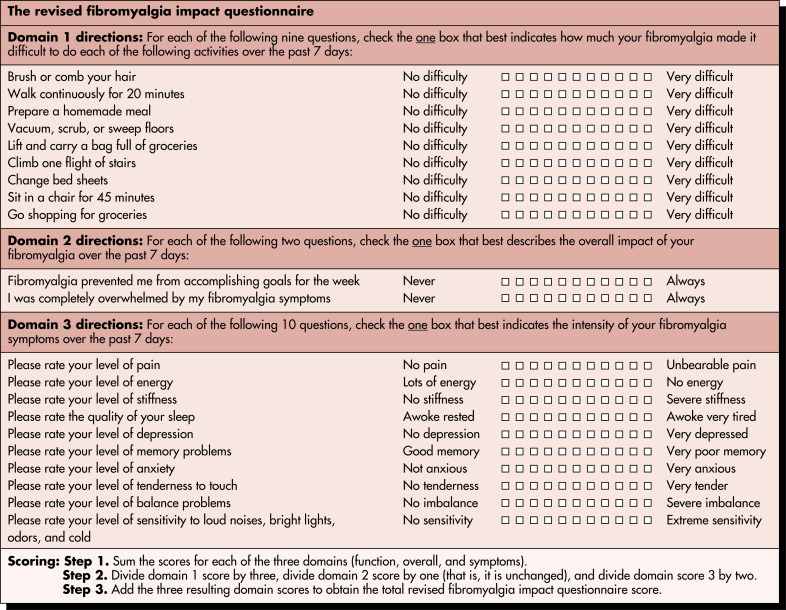AUTHORS: Helen Zhang, BS, and Manuel F. DaSilva, MD
Fibromyalgia (FM) is a syndrome characterized by chronic, widespread musculoskeletal pain without evidence of soft tissue inflammation. Key features include chronic fatigue, sleep disruption, cognitive disturbance, and psychiatric and somatic symptoms. FM can be considered a centralized pain state, with research suggesting that it is a disorder of pain regulation.
The term “fibrositis” is no longer used because there is no evidence of connective tissue inflammation in FM.
| ||||||||
Worldwide, the prevalence of FM is estimated to be between 2% and 8%, increasing with age. FM is most commonly diagnosed in women between ages 40 and 60 yr, but can affect all ages and populations.1
Patients with FM often report the following symptoms:
- Chronic (>3 mo) widespread (affecting both sides of the body, above and below the waist, and involving the axial spine) musculoskeletal pain with tenderness to palpation of at least 11 of the 18 specific tender points associated with FM2
- Cognitive disturbances
- Fatigue and sleep disturbances
- Psychiatric symptoms (e.g., anxiety, depression)
- Headache (present in more than half of patients with FM; includes migraine and tension-type headaches)
- Paresthesias
- Associated disorders: Irritable bowel syndrome, interstitial cystitis/painful bladder syndrome
On physical examination, patients with FM can have tenderness, in particular soft tissue locations called tender points. Examination of tender points requires that the examiner be familiar with the areas to palpate and that they apply enough pressure (4 kg/cm2 or enough to whiten the nail bed of the examiner’s fingertips).
Although the exact cause of FM is unknown, its etiology is thought to be multifactorial:
- Genetic and environmental factors may play a role. Evidence suggests that ascending and descending pain pathways operate abnormally, resulting in central amplification of pain signals.3 Familial associations of FM provide the strongest evidence that reflects both these factors.
- In those predisposed, FM may be precipitated by physical or psychologic stress such as abuse, injury from accidents, illnesses (including autoimmune disorders), infections, and surgical procedures.
- Psychosocial, neuroendocrine, hormonal, and sociocultural factors also influence symptom expression.4
Much remains to be discovered about the pathogenesis of FM, although significant advances have been made over the past few decades. Researchers have shown that biochemical, metabolic, and immunoregulatory abnormalities exist in patients with FM. Hence, this condition is now believed to be neurosensory in nature.
- Augmented pain and sensory processing is a hallmark, resulting in diffuse pain, allodynia (pain brought on by nonpainful stimuli), and hyperalgesia (more intense and prolonged pain perception).5
- Brain imaging studies have demonstrated evidence of increased activation in pain processing networks, suggesting abnormal hyperactivity of pain detection and processing pathways.
- Afflicted persons show altered physiologic responses to painful stimulation at spinal and supraspinal levels.
- Brain neuroimaging studies have identified differences in brain structure, neurochemical concentrations, and functional brain networks in FM compared with control subjects. PET scans have revealed widespread activation of glial cells in the cortex, particularly in the frontal and parietal lobes.6
- Pain augmentation may also result from a loss of tonic inhibition by descending inhibitory pathways from the brain to the spinal cord.7
